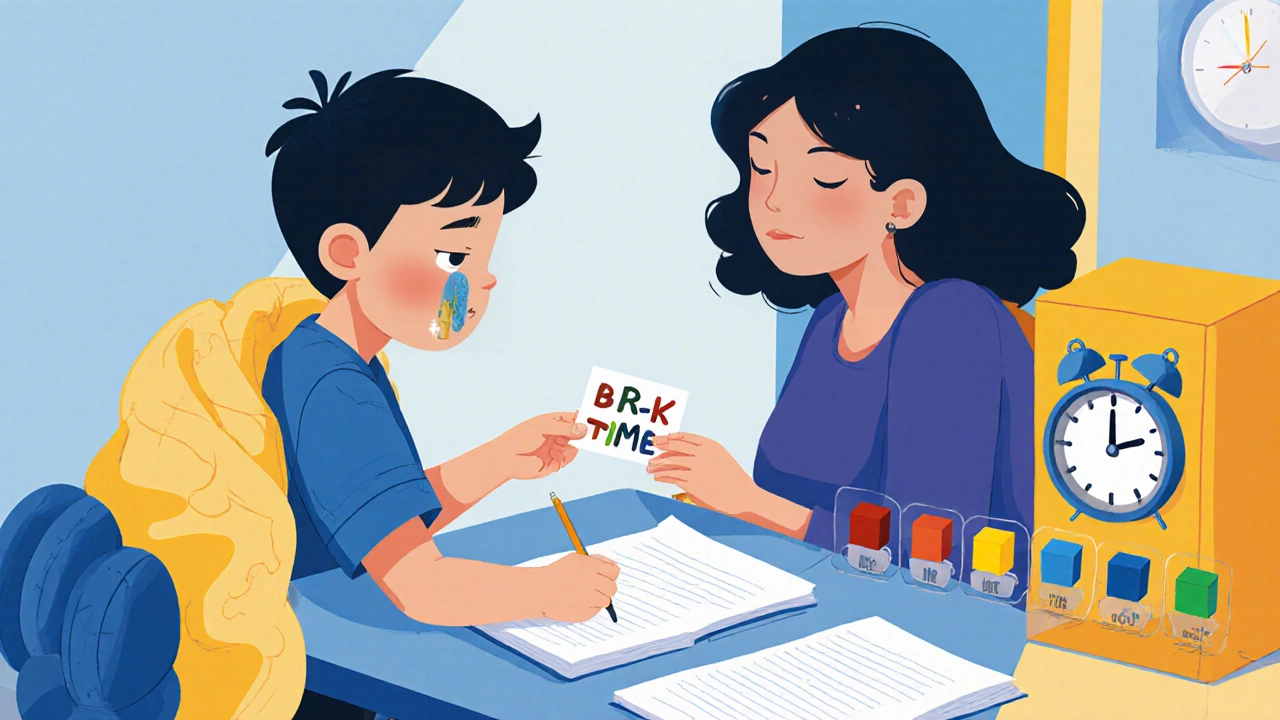Defiance Trigger Tracker
Track Defiance Incidents
Log what triggers defiance and what strategies worked. This helps identify patterns and effective solutions.
When your child with special needs refuses to follow simple instructions, throws tantrums over routine changes, or pushes away help when they clearly need it, it’s easy to feel like you’re failing. You’re not. Defiance in children with autism, ADHD, intellectual disabilities, or sensory processing disorders isn’t about power struggles-it’s about communication breakdowns, sensory overload, or fear of failure. The goal isn’t to break their will, but to understand why they’re resisting and change how you respond.
Understand the Root Cause, Not Just the Behavior
A child with autism who screams when asked to put on shoes isn’t being stubborn. They might be overwhelmed by the texture of the fabric, the sound of the Velcro, or the sudden change in their routine. A child with ADHD who refuses to start homework isn’t lazy-they’re paralyzed by the task’s complexity or unsure where to begin. Defiance is often a symptom, not the problem. Start tracking patterns. When does the defiance happen? What happened right before? Was there a transition? A loud noise? A change in schedule? Keep a simple log: time, trigger, behavior, what you tried, and what worked. After a week, patterns will show up. Maybe your child melts down every time they’re asked to switch from screen time to dinner. Or they shut down after being corrected in front of others. You can’t fix what you don’t understand.Use Clear, Simple Language-And Give Time to Process
Complex instructions are overwhelming. Saying, “Go to your room, get your coat, put on your shoes, grab your backpack, and wait by the door” is too much. Break it down. Say one thing at a time. “Go to your room.” Wait. Let them do it. Then say, “Now get your coat.” Pause again. Use visual supports. Picture cards, checklists, or even photos of the steps (like a sequence of images showing brushing teeth) can replace verbal commands. Many nonverbal or minimally verbal children understand visuals better than words. A visual schedule taped to the fridge can reduce daily power struggles by showing what comes next-no talking needed.Offer Limited Choices to Restore a Sense of Control
Defiance often comes from feeling powerless. When you say, “It’s time for bed,” and they scream, they’re not rejecting sleep-they’re rejecting being told what to do. Give them a sense of control without giving up the structure. Instead of: “Time for bed.”Try: “Do you want to wear the blue pajamas or the green ones?”
Or: “Do you want to brush your teeth before or after reading your book?” Choices should be real and limited-two options max. Too many choices cause anxiety. And never offer a choice where the answer is no. “Do you want to do your homework?” is a trap. Instead: “Do you want to do math first or reading first?”
Build Predictability with Routines
Children with special needs thrive on predictability. Unexpected changes trigger stress, and stress leads to defiance. A consistent daily rhythm reduces anxiety and makes transitions smoother. Create a visual daily routine: wake up → breakfast → school → lunch → home → snack → homework → dinner → bath → bedtime. Use pictures or symbols. Post it where they can see it. When they know what’s coming, they’re less likely to resist. If you need to change the routine-say, a doctor’s appointment-give a heads-up. “Tomorrow after school, we’re going to the clinic. We’ll come home and have your favorite pasta.” Use a visual calendar to mark changes. Even a small sticker on the day can help.
Use Positive Reinforcement-Not Punishment
Punishments like time-outs or taking away screens often make defiance worse. They don’t teach new skills-they just teach fear. Positive reinforcement does the opposite. Catch them being good. Even small efforts deserve recognition. “I saw you put your shoes on without me asking-that was great.” Use specific praise. Generic “good job” doesn’t stick. Create a reward system that matches their motivation. Some kids respond to stickers, others to extra screen time, a walk with a parent, or a special snack. Make a chart together. Three stickers = one small reward. Five = something bigger. Keep it simple. Rewards should be immediate and meaningful to them-not what you think they should want.Manage Your Own Stress-It’s Contagious
When a child is defiant, parents often react with raised voices, frustration, or withdrawal. That energy feeds the cycle. Your stress becomes their stress. Pause before reacting. Take three slow breaths. Count to five. Say to yourself: “This isn’t personal. They’re not trying to hurt me. They’re overwhelmed.” If you feel yourself losing control, say, “I need a minute,” and step away for 30 seconds. Come back calm. Your calm becomes their calm. Also, build in your own support. Talk to a therapist, join a parent group, or just call a friend who gets it. You can’t pour from an empty cup.Collaborate with Teachers and Therapists
Behavior doesn’t happen in a vacuum. What works at home might not work at school-and vice versa. If your child is defiant at school, ask for a meeting with their teacher and any specialists involved (OT, speech, behavior therapist). Ask: “What does defiance look like in class?” “What triggers it?” “What helps?” Share what works at home. Ask them to try the same strategies. Consistency across settings reduces confusion and builds trust. Request a Behavior Intervention Plan (BIP) if one doesn’t exist. A BIP isn’t punishment-it’s a roadmap. It identifies triggers, teaches replacement behaviors (like using a card to say “I need a break”), and rewards progress. Schools in New Zealand are required to support this under the Education and Training Act.
When to Seek Professional Help
Not every tantrum needs a therapist. But if defiance is frequent, intense, and lasts longer than 15 minutes, or if it leads to self-harm, aggression toward others, or school refusal, it’s time to get help. Look for a child psychologist or behavior analyst with experience in autism, ADHD, or developmental delays. They can do a functional behavior assessment (FBA)-a deep dive into why the behavior happens and how to change it. Medication isn’t always the answer, but for some kids with ADHD or anxiety, it can reduce the intensity of emotional outbursts enough for behavioral strategies to work. Talk to a pediatrician about options.Real Example: From Screaming to Saying ‘I Need a Break’
Seven-year-old Leo had autism and would scream and hit when asked to stop playing and do homework. His mom kept yelling, “Just do it!”-and he’d escalate. They started using a visual schedule with a “break card.” Leo could hand it to his mom when he felt overwhelmed. She’d say, “Okay, five minutes. Then we try again.” They started with just five minutes of math, then a break. Gradually, they added time. They also gave him a weighted blanket during homework. The pressure helped him feel calm. Within six weeks, the screaming dropped by 80%. He didn’t stop resisting-but he learned how to ask for help.You’re Not Alone
Defiance doesn’t mean your child is bad. It means they’re struggling to communicate or cope. Your job isn’t to control them-it’s to help them learn how to handle big feelings in a way that works for them. Progress isn’t linear. Some days will be better. Some will feel like you’re back at square one. That’s normal. Celebrate the small wins. A quiet transition. A sentence spoken instead of a scream. A moment of eye contact when they’re calm. You’re teaching them how to survive in a world that wasn’t built for them. That’s not easy. But it’s possible-with patience, strategy, and a lot of love.Is defiance normal for children with autism or ADHD?
Yes, defiance is common in children with autism, ADHD, and other developmental differences. It’s often a response to sensory overload, communication challenges, or feeling out of control. What looks like disobedience is usually a way of saying, “I’m overwhelmed,” or “I don’t know how to do this.”
Should I use time-outs for a defiant special needs child?
Time-outs often backfire. Many children with special needs don’t understand why they’re being isolated, or they find the quiet space even more frightening. Instead of punishment, focus on teaching replacement behaviors-like using a break card or asking for help. Calm redirection works better than isolation.
How do I get my child’s school to help with behavior issues?
Request a formal meeting with your child’s teacher, special education coordinator, and any therapists involved. Ask for a Functional Behavior Assessment (FBA) and a Behavior Intervention Plan (BIP). In New Zealand, schools are legally required to support students with special needs under the Education and Training Act 2020. Bring your own observations and examples to the meeting.
What if my child only misbehaves at home but is fine at school?
This is common. At school, there’s structure, peer influence, and trained staff. At home, the child feels safe enough to let their guard down-and that’s actually a good sign. It means they trust you. Use the same strategies from school-visual schedules, clear routines, limited choices-and ask the teacher for tips on what works in the classroom.
How long does it take to see improvement?
Small changes can show up in 2-4 weeks with consistent strategies. Major shifts often take 3-6 months. Progress isn’t about stopping all defiance-it’s about reducing the frequency, intensity, and duration of outbursts. Look for moments when your child uses a new skill, like asking for a break instead of screaming. That’s real progress.


Write a comment